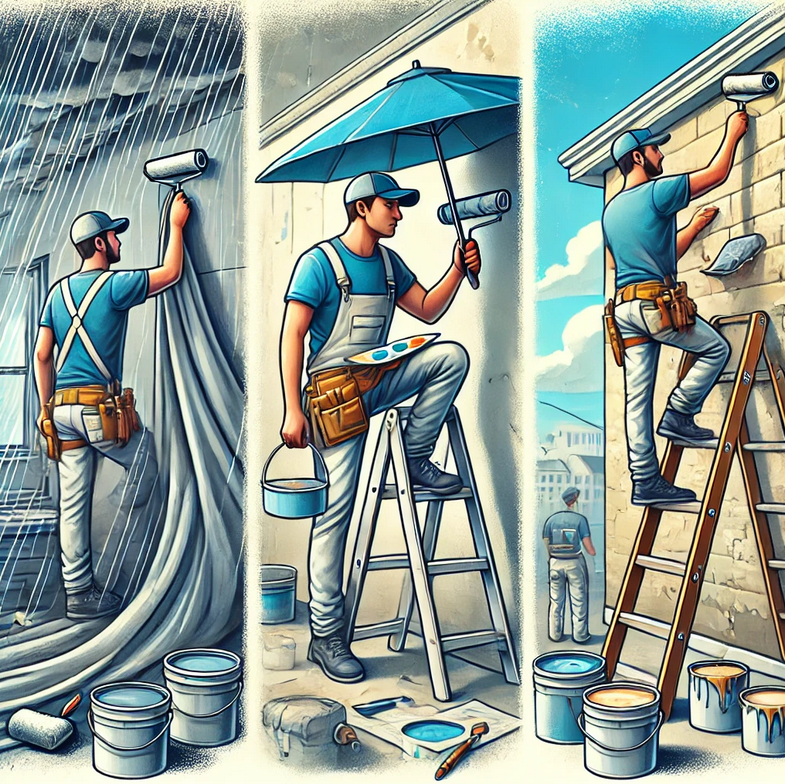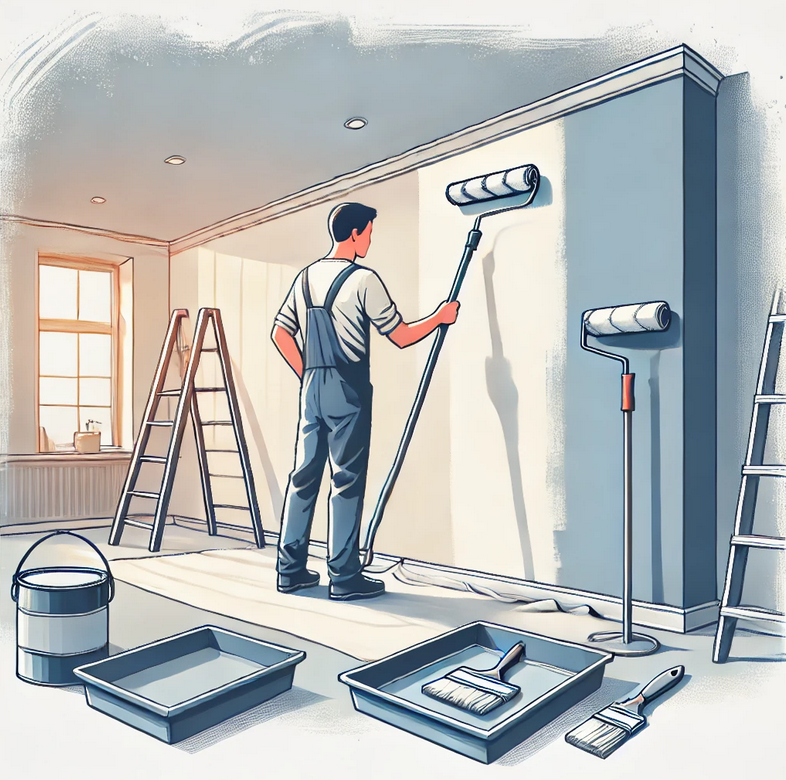What Does a Painter Do?
A painter is a skilled professional whose primary responsibility is to apply paint, stain, and coatings to a variety of surfaces, transforming spaces both aesthetically and functionally. The work of a painter goes beyond simply applying color; it involves careful preparation, a keen eye for detail, and a deep understanding of different materials and techniques to ensure a durable and visually pleasing finish.
Surface Preparation
Before any paint touches a surface, a painter must thoroughly prepare the area. This step is crucial for ensuring that the paint adheres properly and lasts as long as possible. Surface preparation can include cleaning, sanding, filling cracks or holes, and applying primer. In some cases, the painter may also need to remove old paint or wallpaper before starting the new project. Proper preparation helps to create a smooth, even surface that allows the paint to perform at its best, preventing issues like peeling or blistering.
Choosing the Right Materials
A significant part of a painter’s job is selecting the appropriate materials for the project at hand. This includes choosing the right type of paint, whether it’s latex, oil-based, or specialty coatings, depending on the surface and the desired finish. Painters also decide on the best brushes, rollers, or spray equipment to use, ensuring that each tool is suited to the specific job. Understanding the properties of different paints and finishes is essential for achieving the desired look and ensuring the paint’s durability.
Application Techniques
Applying paint is where the painter’s skill and experience truly shine. Painters must use a variety of techniques depending on the surface and the type of paint. For example, a painter might use a roller for large, flat surfaces like walls and ceilings, while a brush is better suited for detailed work around edges and corners. Spray painting may be used for large areas or surfaces that require a very smooth finish. The painter must also be proficient in techniques like cutting in, where straight lines are painted along edges without the use of tape, creating a sharp, professional look.
Attention to Detail
A painter’s job demands a high level of precision and attention to detail. This includes ensuring even coverage, avoiding drips or streaks, and creating clean lines between different colors or surfaces. Professional painters are also responsible for color matching and mixing paints when necessary to achieve the exact shade desired by the client. This attention to detail not only affects the visual outcome but also the longevity of the paint job.
Safety Considerations
Safety is a critical aspect of a painter’s work, especially when dealing with hazardous materials or working at heights. Painters must follow safety protocols, including using appropriate protective gear like masks, gloves, and harnesses. They also need to be aware of ventilation requirements, particularly when using paints that emit strong fumes. By adhering to safety standards, painters protect themselves and those around them while ensuring that the work environment remains safe and healthy.
Skills and Qualifications Required for Painters and Decorators
Painters and decorators are skilled professionals who bring both technical expertise and creative vision to their work. Their role involves transforming spaces by applying paint, wallpaper, and other decorative finishes, all while ensuring that the work is both aesthetically pleasing and durable. To excel in this field, painters and decorators must possess a unique blend of skills and qualifications that enable them to handle the diverse challenges of their craft.

Key Skills for Painters and Decorators
- Attention to Detail: Precision is crucial in painting and decorating. From cutting in edges to ensuring an even coat of paint, the ability to focus on the small details ensures a professional finish that meets client expectations.
- Color Sense and Design Understanding: A strong sense of color and an understanding of design principles are essential for decorators. They must be able to recommend and apply color schemes and patterns that enhance the space and align with the client’s vision.
- Technical Proficiency: Painters and decorators need to be proficient with various tools and techniques. This includes knowledge of different types of paints, brushes, rollers, and spray equipment, as well as how to prepare surfaces for painting and decorating.
- Physical Stamina and Dexterity: The job often requires long hours of standing, climbing ladders, and working with arms raised. Good physical condition and manual dexterity are important for handling these demands efficiently.
- Problem-Solving Skills: Painters and decorators frequently encounter unexpected challenges, such as dealing with uneven surfaces or working in tight spaces. The ability to problem-solve on the spot is essential for overcoming these hurdles.
- Time Management: Efficient time management is key to completing projects on schedule. This involves planning the work process, managing materials, and coordinating with other tradespeople if necessary.
- Communication and Customer Service: Effective communication is important for understanding client needs and explaining options or issues that may arise during a project. Good customer service skills help build trust and ensure client satisfaction.
Qualifications and Training
- Apprenticeships: Many painters and decorators begin their careers through apprenticeships, which provide hands-on experience under the guidance of experienced professionals. Apprenticeships typically combine on-the-job training with classroom instruction, covering everything from basic techniques to advanced skills.
- Vocational Training: Vocational schools and community colleges offer programs in painting and decorating, providing a solid foundation in the skills needed for the job. These programs often include courses on color theory, surface preparation, and safety practices.
- Certifications: While not always required, certifications can enhance a painter or decorator’s credentials. Certifications may cover specialized skills, such as working with eco-friendly materials or mastering specific decorative techniques.
- Continued Education: The painting and decorating industry is constantly evolving, with new materials, tools, and techniques emerging regularly. Continued education and training help professionals stay current with industry trends and maintain a competitive edge.
Types of Painting Services: Interior, Exterior, and Specialty
Painting services are essential for maintaining and enhancing the aesthetic appeal and structural integrity of buildings. Whether you are looking to refresh the look of your home, protect your property from the elements, or add unique decorative touches, there are various types of painting services available to meet your needs. Here, we explore the three main categories of painting services: interior, exterior, and specialty.

1. Interior Painting Services
Interior painting involves the application of paint to the inside surfaces of a building, such as walls, ceilings, doors, and trim. This type of painting service is essential for both new constructions and renovations, offering a wide range of benefits, from improving the ambiance of a space to increasing the value of a property.
- Residential Interior Painting: This service is commonly sought by homeowners looking to update their living spaces. It includes painting bedrooms, living rooms, kitchens, and bathrooms. Painters often work with clients to choose colors that match their personal style and the overall design of the home.
- Commercial Interior Painting: Businesses and commercial properties often require interior painting to create a professional and inviting environment. Whether it’s an office, retail store, or restaurant, a fresh coat of paint can make a significant difference in the appearance and atmosphere of the space.
- Wall Texturing and Finishes: Interior painting services may also include the application of textured finishes, such as faux painting, sponging, and stucco, to create unique visual effects that add depth and character to walls.
2. Exterior Painting Services
Exterior painting is crucial for protecting the outer surfaces of buildings from harsh weather conditions and environmental factors. It also plays a vital role in enhancing curb appeal and increasing the overall value of a property.
- Residential Exterior Painting: This service involves painting the exterior surfaces of homes, including siding, trim, doors, and windows. Professional painters ensure that the paint is applied evenly and that it can withstand exposure to elements like rain, sun, and wind.
- Commercial Exterior Painting: Commercial properties, such as office buildings, warehouses, and storefronts, require exterior painting to maintain a polished and professional appearance. This type of painting often involves the use of durable paints that can resist fading and peeling over time.
- Deck and Fence Painting/Staining: Exterior painting services also extend to outdoor structures like decks and fences. Staining or painting these features not only enhances their appearance but also provides a protective layer that prevents damage from moisture and UV rays.
3. Specialty Painting Services
Specialty painting services cater to unique needs and specific projects that go beyond standard interior and exterior painting. These services require specialized skills and techniques to achieve the desired results.
- Decorative Painting: Decorative painting includes techniques like murals, stenciling, and trompe-l’œil, where artists create intricate designs and patterns on walls and ceilings. This service is often used in both residential and commercial settings to create focal points or themed rooms.
- Epoxy Floor Coatings: Epoxy painting is a popular choice for garages, basements, and industrial spaces. This service involves applying a durable, high-gloss epoxy coating to concrete floors, providing a sleek finish that is resistant to stains, chemicals, and heavy traffic.
- Fireproof and Waterproof Coatings: For buildings that require additional protection, specialty coatings like fireproof and waterproof paints are available. These coatings provide an extra layer of safety and durability, particularly in areas prone to moisture or fire hazards.
Common Challenges Painters Face
Painting might seem straightforward, but professional painters encounter a variety of challenges that require skill, experience, and problem-solving abilities to overcome. From dealing with unpredictable weather to managing client expectations, these challenges can significantly impact the quality and timeline of a project. Understanding these common challenges can help you appreciate the expertise of professional painters and why hiring a seasoned painter is crucial for achieving the best results.

1. Weather Conditions
One of the most significant challenges, particularly for exterior painters, is dealing with unpredictable weather. Rain, humidity, and extreme temperatures can all affect the drying time and adhesion of paint, leading to delays and potential quality issues. Professional painters must carefully plan their work around weather forecasts and know how to adjust their techniques to compensate for less-than-ideal conditions.
2. Surface Preparation
Proper surface preparation is key to a successful paint job, but it can be a complex and time-consuming process. Painters often face surfaces that are damaged, dirty, or uneven, requiring extensive preparation before painting can even begin. This might involve cleaning, sanding, filling cracks, or repairing underlying issues like mold or water damage. Skipping or rushing this step can lead to poor paint adhesion and a shorter lifespan for the paint job.
3. Color Matching and Consistency
Achieving consistent color across large surfaces or matching an existing color can be particularly challenging. Variations in lighting, the underlying surface, or even the paint batch can result in noticeable differences in color. Professional painters use their expertise to mix and apply paint in a way that ensures uniformity, but it requires careful attention to detail and experience to get it right.
4. Working in Confined or Hazardous Spaces
Painters often have to work in tight spaces, at heights, or in areas with limited ventilation. These conditions not only make the job physically demanding but also introduce safety risks. Professional painters are trained to handle such environments safely, using the right equipment and techniques to protect themselves and the property.
5. Managing Client Expectations
Every client has a vision for their space, but translating that vision into reality can be challenging. Painters need to communicate effectively with clients, set realistic expectations, and manage any changes or concerns that arise during the project. This requires not only technical skill but also strong interpersonal skills to ensure that the client is satisfied with the final result.
6. Dealing with Old Paint and Lead
Older buildings may have layers of paint that need to be removed, some of which could contain lead. Dealing with lead paint requires special precautions to prevent health risks. Professional painters must be knowledgeable about these regulations and equipped with the necessary tools and safety measures to handle hazardous materials properly.
Transform your space with expert painting and decorating services from Paint and Handy. Visit our Checkatrade profile to see our reviews and book your free consultation today!

